March 4th, 2008
At the last GWAPA meeting, a couple of bags of Limnophila aquatica were up for auction, and at one point, I think it reached market saturation, as no one was bidding on it. I decided to grab it for a $1.00, despite not really wanting it, but I’m glad I did.
 Limnophila aquatica, or Asian Ambulia as it is commonly known, has been in the hobby for a number of years. Its fine, feathery, leaves add a much softer texture to the tank that other, more solid bodied, plants cannot.
Limnophila aquatica, or Asian Ambulia as it is commonly known, has been in the hobby for a number of years. Its fine, feathery, leaves add a much softer texture to the tank that other, more solid bodied, plants cannot.
The plant is a bright green stem plant that is likely to be the brightest plant in your aquarium. Originally from Southeast Asia, Ambulia requires moderate high to have nice bushy growth. It can also grow very quickly with proper fertilization and CO2, and will reportedly grow out of the water with small blue flowers. I hope to see those flowers at some point!
Asian Ambulia can be propagated like any other stem plant, by cuttings or through side-shoots. So far for me, it’s been a rather fast grower.
Despite not originally having plans to add Limnophila aquatica to my 40G aquarium, it has really added a nice focal point for my aquascape. I’ll post updated pictures of the 40G, once the new plants grow in a little bit more.
Posted in 40G Tank Log, Plant Profiles | 2 Comments »
March 3rd, 2008
You may remember this picture that I took of Rotala macrandra var. ‘Green’ last year at my friend Aaron’s house. He had it growing beautifully in his ADA 90P aquarium. Notice how the leaves are slight, with some hooked edges, and somewhat transparent.
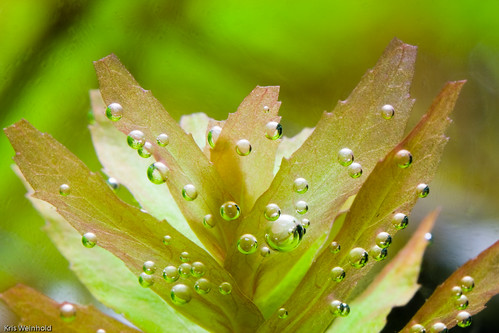
Now, take a look at the picture below. This is the same plant in my 40G tank. The leaves are rounder, thicker, and lacking the spiked edges. Why the difference? Well, about 2 months ago, I got lazy, and didn’t trim this tank, allowing the R. macrandra var. ‘Green’ to grow emersed from the water. Then, I finally performed a water change, raised the water levels, and replanted the tops of the stems, submersing them.
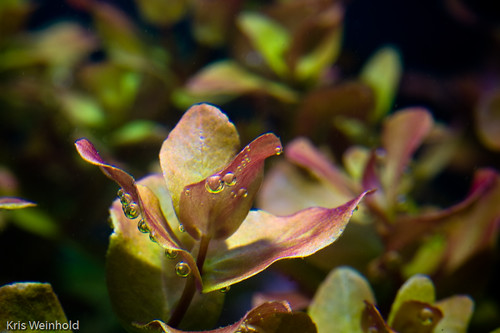
This also coincided with a significant increase of light when I upgraded to the AHSupply 2x96W kit. Since then, the emersed growth form of the Rotala has continued, even though it has been persistantly submersed. I would have figured that the lesser CO2 levels of the water verses the atmosphere would have triggered the plant to convert to its’ submersed form, but apparently not.
I’m still deciding which form I like best. Has anyone else experienced this phenomenon before?
Posted in 40G Tank Log, Plant Profiles | 1 Comment »
March 2nd, 2008
I just wanted to share a couple pictures I took of the Olive Nerite Snails in my 40G aquarium. As mentioned in last week’s algae writeup, these snails are fantastic organisms to have in your aquarium as algae eaters.

Here is a close-up shot of a Nerite Snail grazing on the glass. I imagine that this guy is scraping algae filaments from the glass that aren’t even visible to the naked eye.

Taken 100mm/2.8 with 68mm Kenko extension tubes
Here’s a little bit clearer shot of the snail’s mouth and foot. Their antennae constantly move back and forth over the ground in front of them, and sometimes appear to just flow with the current of the water.

Taken 100mm/2.8 with 68mm Kenko extension tubes
By keeping my nutrients balanced, and these snails in the tank, my tank is not algae free, but kept completely under control.
Posted in 40G Tank Log, Shrimp/Snails | 12 Comments »
March 1st, 2008
Over the past few days, I have noticed that my two females in the 40G have been bright yellow in coloration, and have remained very close to their caves. These are tell-tale signs that they’ve been spawning. It looks like the first female’s fry are now free swimming!

Right now, there is a sizable group of fry, with at least 20-30, but it could be even more. They move around so much, and they all look the same, that it’s near impossible to count. They spend most of the day grazing on tiny organisms and detritus throughout the tank, and especially on the porous mossy rock that contains all kinds of nooks and crannies for them to sort through.

Some of them even seem to take refuge in the small holes formed in the volcanic rock. I don’t plan on trying to remove the fry from the tank, so essentially it’s up to their parents and the cover of these rocks and plants to grow them up. I will, however, prepare a batch of baby brine shrimp for them this week to help them grow up big and strong.

Posted in 40G Tank Log, Fish Fry, Fish Profiles | 2 Comments »
February 3rd, 2008
I noticed some increased fin flashing activity in my 40G tank, and decided to try and capture a few good shots of my Apistogramma sp. ‘Rotpunkt.’ Some of the shots are better than others, but there’s no doubt that these are some pretty fish, whose colors especially pop under the new 2x96W lights!

Apistogramma sp. ‘Rotpunkt’ Male Flashing Fins

A. sp. ‘Rotpunkt’ Male Front On
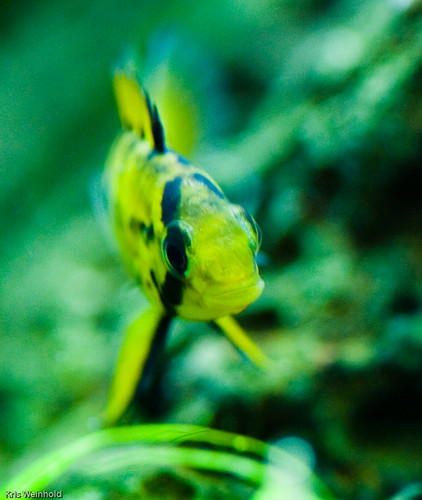
A. sp. ‘Rotpunkt’ Female in Spawning Colors

A. sp. ‘Rotpunkt’ Male Close Up. Notice how brilliant the blue on the face is.

A. sp. ‘Rotpunkt’ Non-Dominant Male. Not nearly as impressive, huh?

A. sp. ‘Rotpunkt’ Male Coming at You.
I should have used a flash above the tank to shoot at a better quality ISO, but I always end up spooking the fish in order to set that up.
Thanks for looking! Any comment/critiques are welcome, as always!
Posted in 40G Tank Log, Fish Profiles | 9 Comments »
January 29th, 2008
I’ve been growing Ranalisma rostrata in my 40G tank as the foreground for some time. When I originally setup my 20H, I decided to also plant it in there. As the 20H progressed, I realized that I had too much light, too little CO2, and too little desire to maintain the tank as I really wanted. Therefore, I removed the 55W PC light from overtop, and replaced it with an ordinary 15W fluorescent light strip. Over the past few months, besides being considerably darker than it was before, I’d noticed a huge change in the form of the Ranalisma rostrata in that tank.
Witness how the grassy plant looks in my 40G. Compact growth, overlapping each other, where each blade is thin and relatively uniform.
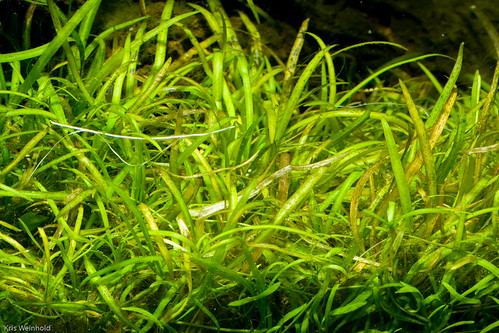
In my 20H, the growth is quite different (below), with blades more resembling a sword plant, than grass. The blades are longer and the growth is much slower. I suspect that the plant is sending out broader leaves to try and soak up more light since less is available. The color is also slightly different, with the broader leaves being a bit more pale, with a yellowish tint, where the regular form is a bright green.
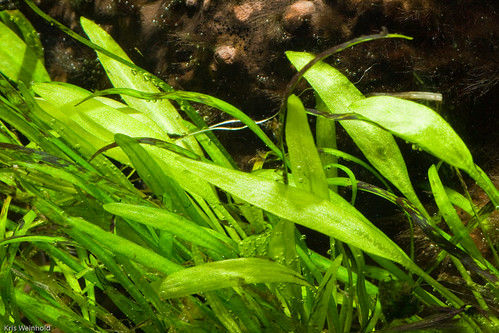
I’m sure that this same phenomenon is present in a wide variety of plants, which is why it’s difficult to say exactly how a plant will grow in another person’s tank. I’m often asked at GWAPA meetings whether a plant is high light or not. In general, I can usually only respond that I’ve only ever grown it in high light, but that they should try it out, and see if it survives in their tank. Now, I can’t even guarantee that it’ll look the same!
Posted in 20L Tank Log, 40G Tank Log, Plant Profiles | 3 Comments »
January 21st, 2008
Back in June 2007, a few GWAPA members went down to Florida to see what kinds of plants/fish we could find for our aquariums. One plant that was absolutely everywhere was a Hydrocotle species that mixed into the grass of people’s lawns, and existed in virtually every roadside ditch we visited. I grabbed a small amount, expecting it to completely take over my tank.
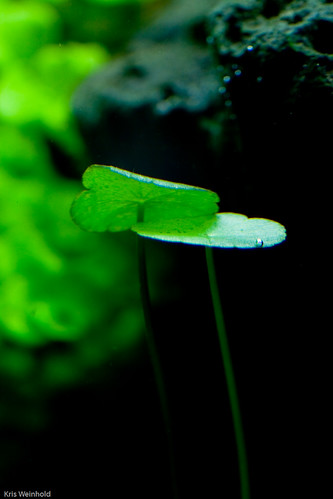
I couldn’t have been more wrong. This small plant has been living in my 40G tank for over 6 months, while only throwing up a single new stem. Recently, I upgraded my lighting to a 2x96W setup from AHSupply and I’ve noticed that the Hydrocotle sp. has started to grow, sending up a new stem and leaf in just the last week. Right now, the stems are approximately 6 inches tall, which is slightly taller than I’d prefer them. I’ll be sure to post if it evens out, and becomes a nice accent plant in my aquascape.
Posted in 40G Tank Log, Florida, Plant Profiles | 2 Comments »
January 14th, 2008
On Saturday, I decided to install a new AHSupply 2x96W kit into the canopy over my 40G aquarium. I used to have ODNO lighting on this tank, but I wasn’t comfortable with the amount of energy being wasted to squeeze out a little bit more light from the 36″ 30W bulbs. Below is what that configuration looked like: 4 bulbs driven by 4 ballasts, over cheap shop-light reflectors.

After I removed the existing equipment, I was pretty happy with the condition of the wood. When I built this canopy, I put extra coats of finish to prevent moisture damage. It held up to the moisture and heat pretty well!

I chose to go with AHSupply’s 96W kit because they have fantastic aluminum reflectors, and the 96W bulb fits a 3′ tank perfectly. I know that T5 lighting is all of the rage these days, but I’d prefer to stick with a consistent power compact lineup so that I can buy replacement bulbs in bulk for all of my tanks.

The kit comes with a set of very detailed instructions for installing into a canopy, or building a DIY strip-light enclosure. Everything you need for either configuration is included. To start, I installed the reflectors and bulb clips into the canopy.

The reflectors come with a yellow plastic film over top of them to avoid scratches during installation. They’re a fantastic parabolic reflector that really focuses most of the light output from the bulb down into the tank. They claim that their reflectors make their setup produce 2.5X as much light as a store-bought solution.

Wiring up the ballast was very straight-forward thanks to the included wiring diagram. The hardest part was trimming the wires to length, and stripping them to use the wire nuts. After screwing down the 2 ballasts, and installing the bulbs, I was all done.

Time to fire them up — Man are they bright! It seems like they’re 10X brighter than my old ODNO lights, using equal or less the wattage. By mid-afternoon, the entire tank was pearling more than I’ve seen it pearl in years. This continued for 3 straight days, so I’ve increased my CO2 injection, and dosing amount to compensate. The fish really pop under these lights as well. I’d recommend AHSupply products to anyone looking for a DIY lighting solution.

Posted in 40G Tank Log, Equipment | 4 Comments »
December 22nd, 2007
It’s been awhile since I last showed a picture of my 40G tank. I’ve been trying to fight an algae problem in this tank by adding more circulation. I recently hooked up an old Fluval 304 canister filter that I had sitting in the basement. It did a good job for awhile, but just yesterday, I noticed that it had air-locked, and was not circulating any water. I have no idea why that happened, as I’m not injecting any CO2 into this filter — that still goes through the Eheim 2213 — but it happened nevertheless. Hopefully that won’t be a reoccurring situation.

Additionally, I recently added Didiplis diandra and Rotala rotundifolia to the back, right-hand, corner, so that’s why it’s a bit bare back there in this picture. (It still hasn’t grown over-top of the rocks.) I need to trim the Rotala macrandra var. ‘green,’ but I’m very pleased with how orange it is getting, with nice bushy growth. I still can’t say enough nice things about the Eriocaulaceae sp. ‘Type 2’ as it doesn’t shoot to the water’s surface, regardless of whether I trim it or not. I love how it wraps around from the foreground to background, and can be trimmed to pretty much whatever mid-ground height I want it to stay at.
On a different note, I hope everyone has a safe and happy holiday! Cheers!
Posted in 40G Tank Log | Comments Off on 40G Scape – Holiday Update
December 16th, 2007
This weekend, I finally decided that both Hygrophilia sp. ‘Sarawak’ and the Potamegeton sp. from Florida were not working well in my aquascape. I wanted to add some smaller leafed stems, and happened to see Didiplis diandra and Rotala rotundifolia at a local fish store, so I bought a few stems of each. Ripping out the previous two plants ended up sending debris all throughout the tank, as you can see on the Anubias leafs below.
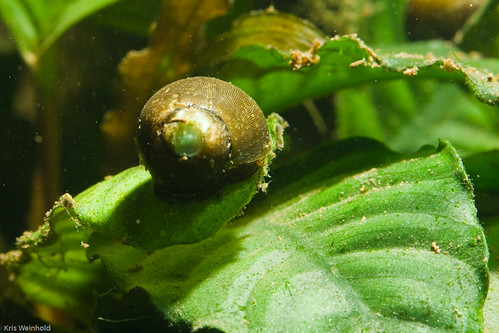
Speaking of the Anubias barteri ‘coffeefolia,’ it is growing quite nicely in the tank right now. It’s sending up new leaves rather frequently, and the Olive Nerite Snails, are doing their job keeping them largely free of spot algae. (If I could keep some hair algae out of this tank, that would be fantastic!)
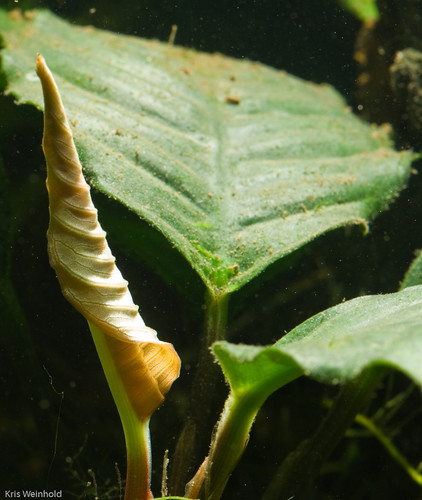
Additionally, probably about 3 months ago, I purchased a bag of Windelov’s Java Fern at a GWAPA auction. As soon as I stuck it in the tank, it completely melted. I’m glad to see that the rhizome did not die, as it’s finally sending up some new leaves, as shown below.
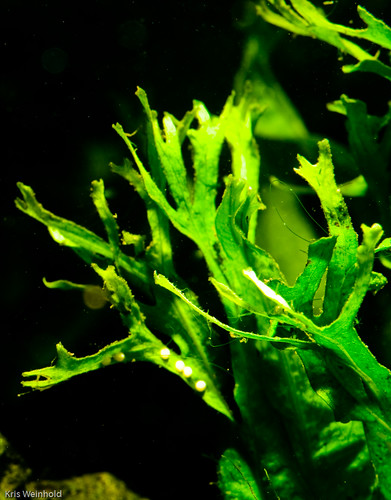
Any time I get around this particular tank with a camera, the fish either go perfectly still, or hiding in the back corners. Luckily, this time, I caught this group of Melanotaenia praecox hovering, watching me and my camera very closely. Every time the flash went off, this fish got a little bit spooked, so after 1-2 shots, I let them be.

Posted in 40G Tank Log | Comments Off on 40G: Odds and Ends
 Limnophila aquatica, or Asian Ambulia as it is commonly known, has been in the hobby for a number of years. Its fine, feathery, leaves add a much softer texture to the tank that other, more solid bodied, plants cannot.
Limnophila aquatica, or Asian Ambulia as it is commonly known, has been in the hobby for a number of years. Its fine, feathery, leaves add a much softer texture to the tank that other, more solid bodied, plants cannot.



























